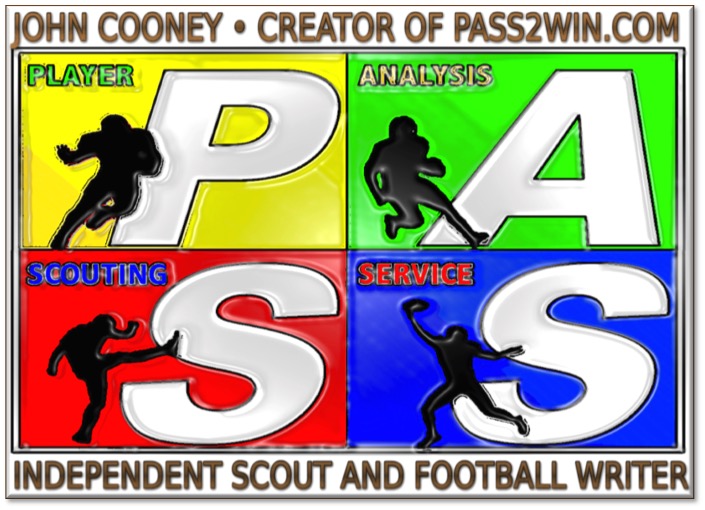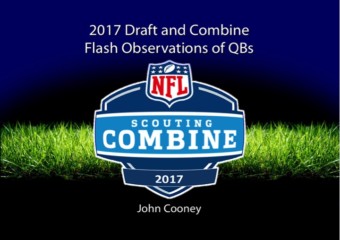2017 Draft and Combine Flash Observations of QBs with John Cooney
John Cooney is editor and chief of PASS2Win.com
CJ Beathard, Iowa
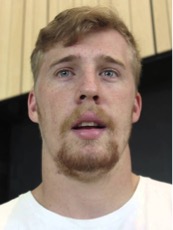 Beathard goes an NFL-worthy 6’3-219. He played in a pro-style offense at Iowa, most often under center. The former soon-to-be former Hawkeye QB shows natural QB smarts and solid mechanics. He drops back quickly and efficiently, with excellent high ball carriage at or above the shoulders. Beathard sets up in good throwing platform and shifts feet well, always ready to fire off his rapid delivery. Iowa passing game includes a lot of horizontal throws at or behind the line of scrimmage, meaning Beathard’s completion percentage should have been much higher than his paltry career 58.1 log. 2015 was Beathard’s most “accurate”, hitting on just 61.6%. He does show plenty of arm when going vertical and though seemingly careful with the football, Beathard is not afraid to “stick it” through a tight window. He works mainly between the numbers and has not been asked to hit those tough sideline throws often at Iowa. A rather average supporting cast may be part of the blame for his weak completion tally. Beathard’s sudden release gets the ball to his targets fast and timely on short and intermediate throws. Deep accuracy is needy. CJ Beathard looks every bit a pro QB on tape, but his numbers at Iowa are far from impressive. Again, surrounded by better talent, Beathard could be a meaningful starting QB in the NFL. His Combine work is going to answer many questions.
Beathard goes an NFL-worthy 6’3-219. He played in a pro-style offense at Iowa, most often under center. The former soon-to-be former Hawkeye QB shows natural QB smarts and solid mechanics. He drops back quickly and efficiently, with excellent high ball carriage at or above the shoulders. Beathard sets up in good throwing platform and shifts feet well, always ready to fire off his rapid delivery. Iowa passing game includes a lot of horizontal throws at or behind the line of scrimmage, meaning Beathard’s completion percentage should have been much higher than his paltry career 58.1 log. 2015 was Beathard’s most “accurate”, hitting on just 61.6%. He does show plenty of arm when going vertical and though seemingly careful with the football, Beathard is not afraid to “stick it” through a tight window. He works mainly between the numbers and has not been asked to hit those tough sideline throws often at Iowa. A rather average supporting cast may be part of the blame for his weak completion tally. Beathard’s sudden release gets the ball to his targets fast and timely on short and intermediate throws. Deep accuracy is needy. CJ Beathard looks every bit a pro QB on tape, but his numbers at Iowa are far from impressive. Again, surrounded by better talent, Beathard could be a meaningful starting QB in the NFL. His Combine work is going to answer many questions.
Josh Dobbs, Tennessee
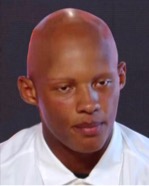 Dobbs is a heck of an athletic QB. He stands in at 6’3-216 and might break a high 4.6-forty dash at the Combine. AtTennessee Dobbs ran an up-tempo offense, working mostly from the shotgun. He has a nose for the endzone, both throwing and rushing. Over the past 2 seasons Dobbs accounted for 65 combined scores, including 23 TD runs in that span. He’s tucked the ball to run 296 times over his last 2 seasons as a Volunteer. Dobbs has some mechanical work to do as he heads to the NFL. He shows a low ball carriage, causing wasted time repositioning for release. He does mask the flaw with a quick, compact release. Dobbs displays an easy, smooth and QB-beautiful throwing motion and has plenty of velocity on all his throws. Good, high release point. His footwork is urgent and sound. Actually, I’m impressed with his seemingly natural QB motor skills. He sets up quickly, in good platform and gets the ball out fast and timely. Overall accuracy needs sharpening. Dobbs ran a one-read and throw scheme at Tennessee. Pro defenses will cause progression challenges for Dobbs in his early years in the NFL. He doesn’t anticipate or decipher coverages well and rarely looked off his initial target in college, covered or not. Dobbs doesn’t throw receivers open; he needs a clean look. When forced past his first read, poor decisions are likely to come from Dobbs. Josh Dobbs is an athletically gifted QB with pro size and a wonderfully natural throwing motion. His major work will come in the film room and expanding his ability to read defenses. A key look at the Combine will be his accuracy in throwing drills.
Dobbs is a heck of an athletic QB. He stands in at 6’3-216 and might break a high 4.6-forty dash at the Combine. AtTennessee Dobbs ran an up-tempo offense, working mostly from the shotgun. He has a nose for the endzone, both throwing and rushing. Over the past 2 seasons Dobbs accounted for 65 combined scores, including 23 TD runs in that span. He’s tucked the ball to run 296 times over his last 2 seasons as a Volunteer. Dobbs has some mechanical work to do as he heads to the NFL. He shows a low ball carriage, causing wasted time repositioning for release. He does mask the flaw with a quick, compact release. Dobbs displays an easy, smooth and QB-beautiful throwing motion and has plenty of velocity on all his throws. Good, high release point. His footwork is urgent and sound. Actually, I’m impressed with his seemingly natural QB motor skills. He sets up quickly, in good platform and gets the ball out fast and timely. Overall accuracy needs sharpening. Dobbs ran a one-read and throw scheme at Tennessee. Pro defenses will cause progression challenges for Dobbs in his early years in the NFL. He doesn’t anticipate or decipher coverages well and rarely looked off his initial target in college, covered or not. Dobbs doesn’t throw receivers open; he needs a clean look. When forced past his first read, poor decisions are likely to come from Dobbs. Josh Dobbs is an athletically gifted QB with pro size and a wonderfully natural throwing motion. His major work will come in the film room and expanding his ability to read defenses. A key look at the Combine will be his accuracy in throwing drills.
Jerod Evans, Virginia Tech
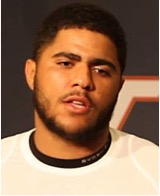 Good looking athlete with a strong arm. Though athletic Evans is a rather robotic and mechanical thrower of the football. He is stiff in movement and not overly creative as a passer. There’s a windup in his pre-delivery that causes late arrivals of the ball. Accuracy isn’t his strong suit either. He can gain yards rushing, but again, he’s not fluid and natural, runs too upright and rigid. There’s potential here, but with a definite ceiling.
Good looking athlete with a strong arm. Though athletic Evans is a rather robotic and mechanical thrower of the football. He is stiff in movement and not overly creative as a passer. There’s a windup in his pre-delivery that causes late arrivals of the ball. Accuracy isn’t his strong suit either. He can gain yards rushing, but again, he’s not fluid and natural, runs too upright and rigid. There’s potential here, but with a definite ceiling.
Brad Kaaya, Miami- Florida
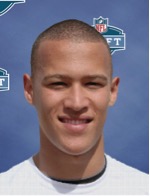 Some say Kaaya is making a mistake coming out a year early. Plays with poise and confidence. Great ball skills, excellent ball carriage and always ready to pull the trigger. Spins a tight spiral and shows a live arm. Uses the entire field. I like what I see. Many feel his 2016 campaign was a down year, but he created plentiful good tape for pro personnel people. His NFL activity projection is a couple of seasons away. But keep tabs… I like this guy.
Some say Kaaya is making a mistake coming out a year early. Plays with poise and confidence. Great ball skills, excellent ball carriage and always ready to pull the trigger. Spins a tight spiral and shows a live arm. Uses the entire field. I like what I see. Many feel his 2016 campaign was a down year, but he created plentiful good tape for pro personnel people. His NFL activity projection is a couple of seasons away. But keep tabs… I like this guy.
DeShone Kizer, Notre Dame
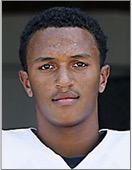 The Irish QB is a streaky power passer that is far from a polished product. Kizer is quite similar to Jacksonville’s Blake Bortles coming out of college in that he rarely modulates velocity on his throws to fit the situation and will force the ball into compromising windows. He is big and strong, and a fine athlete who can break out of the pocket and grab chunky yards rushing. Kizer is a powerful runner and surprises tacklers with his speed as well. He could use another full season of college ball in a big-time program like Notre Dame to hone his craft. Think Cardale Jones, the Bills’ 2nd year backup; yeah, he didn’t play as a rookie either.
The Irish QB is a streaky power passer that is far from a polished product. Kizer is quite similar to Jacksonville’s Blake Bortles coming out of college in that he rarely modulates velocity on his throws to fit the situation and will force the ball into compromising windows. He is big and strong, and a fine athlete who can break out of the pocket and grab chunky yards rushing. Kizer is a powerful runner and surprises tacklers with his speed as well. He could use another full season of college ball in a big-time program like Notre Dame to hone his craft. Think Cardale Jones, the Bills’ 2nd year backup; yeah, he didn’t play as a rookie either.
Trevor Knight, Texas A&M
 Like others in the recent past, Trevor Knight is another athletic, creative QB from Texas A&M. And like his recent predecessors, Knight comes with some flaws. He played at Oklahoma from 2012 to 2015 and was the MVP of the 2014 Sugar Bowl. Knight is not big at 6’-215. The Aggies’ QB is a gifted rusher with good wheels (4.7-forty) and excellent vision. He is active and mobile in and out of the pocket, with sharp pocket awareness. Working from the shotgun exclusively, Knight rarely sets his feet to throw and is often delivering off-balance, on the run or from the back foot. He shows scatter-shot accuracy when his feet are not set, but his accuracy improves immensely when he does. That doesn’t happen often. He has NFL-worthy velocity on histhrows, but is late getting the ball to his receivers at times due to a wind-up motion in his delivery. His mobility negates his lack of height and he fluidly changes release points as needed. Knight throws with smooth mechanics and natural feel, but the need to cock-to-throw will allow elite pro CBs to read and break on his throws, especially ones directed to the sidelines. Trevor Knight is a fun QB to watch, but he has to add a dose of discipline and pass tech fundamentals to make noise in the NFL.
Like others in the recent past, Trevor Knight is another athletic, creative QB from Texas A&M. And like his recent predecessors, Knight comes with some flaws. He played at Oklahoma from 2012 to 2015 and was the MVP of the 2014 Sugar Bowl. Knight is not big at 6’-215. The Aggies’ QB is a gifted rusher with good wheels (4.7-forty) and excellent vision. He is active and mobile in and out of the pocket, with sharp pocket awareness. Working from the shotgun exclusively, Knight rarely sets his feet to throw and is often delivering off-balance, on the run or from the back foot. He shows scatter-shot accuracy when his feet are not set, but his accuracy improves immensely when he does. That doesn’t happen often. He has NFL-worthy velocity on histhrows, but is late getting the ball to his receivers at times due to a wind-up motion in his delivery. His mobility negates his lack of height and he fluidly changes release points as needed. Knight throws with smooth mechanics and natural feel, but the need to cock-to-throw will allow elite pro CBs to read and break on his throws, especially ones directed to the sidelines. Trevor Knight is a fun QB to watch, but he has to add a dose of discipline and pass tech fundamentals to make noise in the NFL.
Patrick Mahomes II, Texas Tech
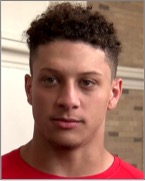 There’s a lot to like here; size, smarts, mobility, toughness and a live arm. Over 5000 yards and 41 TDs in 2016. Last season alone Mahomes exploded 6 games of 470 or more passing yards, including three 500+ yard performances and 734 air miles versus Oklahoma. Added 12 rushing TDs to his 41 throwing scores. He’s a QB’s son and it shows on the field. He just plays like he “knows”. Yeah, OK, Texas Tech’s offense is essentially an on-field video game, but in that fun scheme a QB had best thrive; Pat Mahomes surely did thrive. This is an NFL QB, but he needs a little time.
There’s a lot to like here; size, smarts, mobility, toughness and a live arm. Over 5000 yards and 41 TDs in 2016. Last season alone Mahomes exploded 6 games of 470 or more passing yards, including three 500+ yard performances and 734 air miles versus Oklahoma. Added 12 rushing TDs to his 41 throwing scores. He’s a QB’s son and it shows on the field. He just plays like he “knows”. Yeah, OK, Texas Tech’s offense is essentially an on-field video game, but in that fun scheme a QB had best thrive; Pat Mahomes surely did thrive. This is an NFL QB, but he needs a little time.
Mitch Trubisky, North Carolina
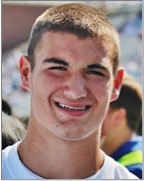 Not only is this impressive QB coming out a year early, he may be the best pure QB in this draft. A one-year starter at North Carolina, Trubisky turned 2016 into a money-maker. He played fast, threw accurately, was mobile and displayed impressive confidence. Wow, what an arm! Under a creative QB coach in the NFL, Trubisky will flourish. He’s the full pro package; big arm, big frame, effectively mobile and a natural thrower. Keep Trubisky in perspective as he has just one season in college as a starter and is hitting the draft as a senior. He needs time and good coaching, but he’ll star if in the right NFL environment.
Not only is this impressive QB coming out a year early, he may be the best pure QB in this draft. A one-year starter at North Carolina, Trubisky turned 2016 into a money-maker. He played fast, threw accurately, was mobile and displayed impressive confidence. Wow, what an arm! Under a creative QB coach in the NFL, Trubisky will flourish. He’s the full pro package; big arm, big frame, effectively mobile and a natural thrower. Keep Trubisky in perspective as he has just one season in college as a starter and is hitting the draft as a senior. He needs time and good coaching, but he’ll star if in the right NFL environment.
Deshaun Watson, Clemson
 Watson followed up his stellar 2015 campaign with a slightly less spectacular performance but led Clemson to a college national title. He is not a perfect passer, but he is NFL level good and a superb athlete. I see Watson as a better version of Cam Newtown coming out of Auburn. Impressive, heady for a young QB. Watson owns RB-quality rushing skills. He’s smart with the football be-it rushing or tossing the rock. Ball carriage is somewhat low, creating a slight hitch or ‘flick’ in his delivery and there is some windup before delivering the ball. But he gets it there with zip and mostly on-time. Watson is especially sharp hitting deep routes and dropping the ball in the bucket. He’s played plenty of big games at Clemson the past 2 seasons and may be more pro-ready than most project. His biggest drawback heading to the NFL is the challenge of half-field play calls. He has to make sideline-to-sideline progressions in the pros. Again, good NFL coaching is key for Watson.
Watson followed up his stellar 2015 campaign with a slightly less spectacular performance but led Clemson to a college national title. He is not a perfect passer, but he is NFL level good and a superb athlete. I see Watson as a better version of Cam Newtown coming out of Auburn. Impressive, heady for a young QB. Watson owns RB-quality rushing skills. He’s smart with the football be-it rushing or tossing the rock. Ball carriage is somewhat low, creating a slight hitch or ‘flick’ in his delivery and there is some windup before delivering the ball. But he gets it there with zip and mostly on-time. Watson is especially sharp hitting deep routes and dropping the ball in the bucket. He’s played plenty of big games at Clemson the past 2 seasons and may be more pro-ready than most project. His biggest drawback heading to the NFL is the challenge of half-field play calls. He has to make sideline-to-sideline progressions in the pros. Again, good NFL coaching is key for Watson.
.
